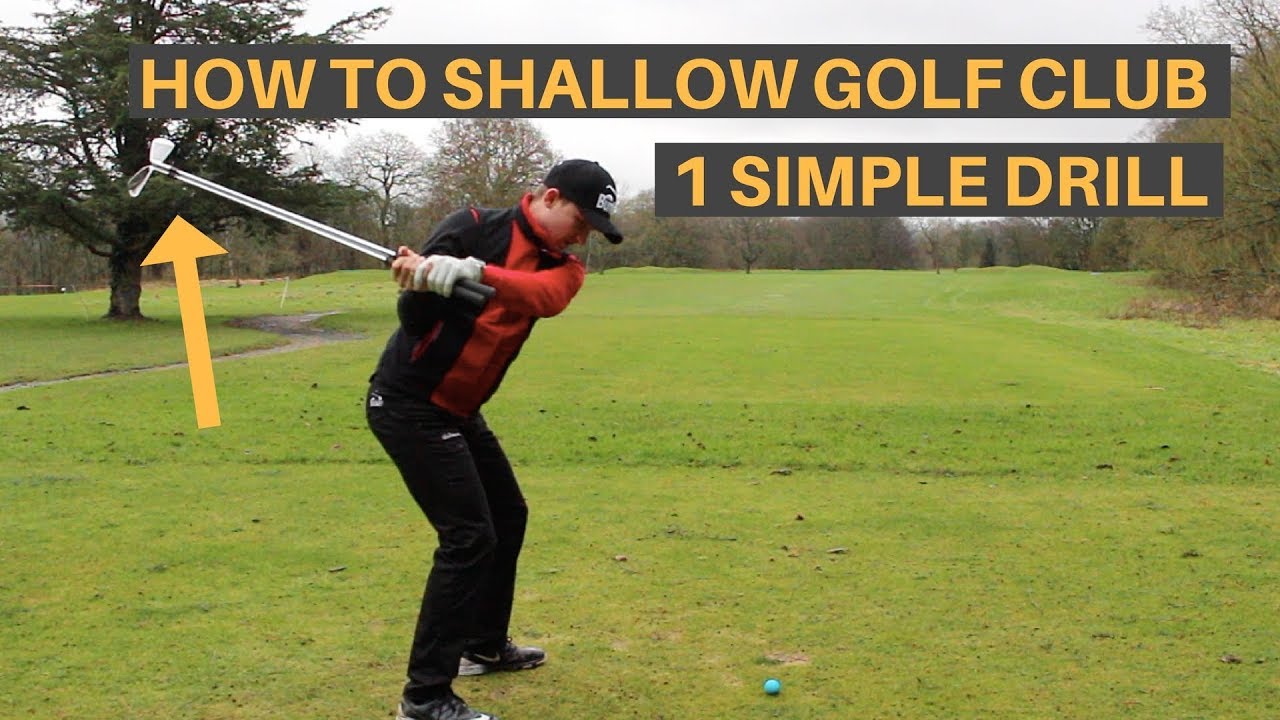
Shallowing or making the golf club more horizontally flat, is a golf technique that frustrates many players who want to implement it in their downswing. Golfers searching for the magic angle should continue with their pursuit because shallowing the golf club varies in aim depending on the special physical attributes of the player. The height, frame, and weight contribute significantly to how golfers must maneuver for them to shallow their downswing effectively.
What Does Shallowing your Golf Swing Mean?
In golf, shallowing your swing and specifically, the downswing simply means getting the club to flatten horizontally. Most golfers tend to have this angle extremely steep and this results in golf shots that are poorly struck.
This is a trait that is characteristic of amateur and leisure golfers and they produce left to right spin and shots which flare out to the right. However, for one to become a great ball striker, it is crucial to attack the golf ball from the inside and the swing from inside towards the outside.
To attain a shallow golf swing, there is a perfect angle that you should aim for and this varies from one player to another depending on your body size and height. You want to get your golf club to split your right forearm in the downswing. This simply means that you have shifted the golf club low enough to achieve an optimum angle when striking the ball.
Gofers need to first be aware of the elements in their golf swing and rotation that should be examined. This way, they can continuously practice and make the necessary adjustments. This article will give you all the information you need to know about shallow golf swings and how it impacts the downswing process.
Mistakes Golfers Make When Shallowing the Downswing
Most golfers tend to take their downswings too steep and this places the clubhead on an incorrect angle with the toe and heel of the club. Most golfers tend to neglect the most critical element that happens when they come down of their downswing. You can only produce the desired shots when you manage your downswing correctly and enter the right swing plane.
By understanding how you can force the clubface to strike the ball directly and on the right angle, you will generate the shallowing effect that evades most golfers who are practicing this golf strategy. Since most golfers are right-handed, they have challenges pulling from their left sides. As a result, they end up overusing the right side when drawing power during their golf swing. When you allow the body’s right side to control your downswing, there are high probabilities of going too much over the tip, and this generates a steeper route to the impact that results from veering inside the swing plane.
Why are Most Players Too Steep?
If your angle of attack is not shallow at this time, then it means that you are probably coming down extremely steep on your transition. This may be happening because of several reasons and one of it is the arms or hands. However, most players are not beginning their downswing with their hips too.
At the launch of the downswing, there must be a slight movement down into the ground. This helps to generate power and utilize the legs more in the golf swing. This is a small squat that helps to activate your legs.
When you watch the pro golfers in slow motion, you can notice how the first move of their downswing is into the ground. They use their legs to generate tons of power for torque and momentum. Consequently, they can use their lower body and weight to consistently hit the ball.
Conversely, many beginners and leisure golfers tend to do the opposite and always begin the downswing with the upper body. They tend to cast the upper half of their bodies rather than using their legs, as a result, they are unable to transfer their body weight to their lead foot. This makes it almost impossible to utilize the lower body to slow down while on the way down. Furthermore, it results in a steep motion, which leads to hitting golf shots widely inconsistently.
According to research, 80% of golfers usually hit pull hooks, pulls, and slices because of a too steep downswing. To hit the best golf shots, you need to learn how to play like the pro golfers and shallow out your swing. You should learn how to utilize the left side of your body to pull your arms, shoulders, and hands into the right plane onto the downswing. With a lot of practice, you will learn shallowing your golf swing and will enjoy consistent shots and your overall gaming experience will be enhanced.
The Key Factors for Shallowing Your Downswing Correctly

-
Properly Shift Your Body Weight
When attempting to shallow your downswing, you need to correct your angle of attack by appropriately shifting the body weight. Correctly shifting your body weight is crucial to your downswing as it naturally prevents you from coming down too steeply. When you come down too steep, it will result in groped swing adjustments that will ruin your golf shot.
During your downswing, 80% of your weight will be transferred to the lead leg. The body will use the ground to leverage power and for many golfers, this may sometimes feel like a tiring exercise on its own. Although this downswing technique is often overlooked by golfers, it helps to set you up for success as you pursue to shallow out your club.
-
Allow Gravity to Do the Work On Your Club
Although your weight shift is balanced, gravity becomes crucial on the downswing. You should allow the gravitational force to take your club through the swing and enjoy the accurate shallowing on your angle of attack. In this case, you should not try to physically push your golf club down towards the ground. If you try forcing the movement at this juncture in the swing, even a bodyweight that is perfectly balanced will not save the golfer from ending up with pulled shots, slices, or going over the top.
Many golfers always try to shallow out their club and will end up doing too much on their downswing. However, you do not want to overcorrect your move and feel as though you are pulling your club down. Instead, you should focus on making the right weight shift and start the swing using your lower body. When you do this and you have the right wrist position, then everything will fall into place. You should not worry about anything because the force of gravity will do its job.
-
Check the Left Wrist
One of the major reasons why most golfers tend to come down steep is because they do not maintain a flat lead wrist when at the top of their backswing. However, they always have a cupped wrist. To shallow out on the downswing, you should make your left wrist flat. Flattening the left wrist helps to prevent any bending from hindering the downswing. However, this is something that many golfers overlook.
Players must focus on ensuring that the left wrist is flat or bowed at the very start of their downswing and follow through upon impact. When you simultaneously keep the left wrist flat with these maneuvers, it will result in one of the best shallowed out golf swings that will truly turn heads on the golf course. If you feel that you are struggling with consistency, you need to check out the left wrist after your backswing is complete. If the wrist is bowed, your golf club should be slightly laid off and this allows you to drop your golf club into position on the way down.
-
Slow Down
When you get time and opportunity, you should personally watch an LPGA or PGA Tour event. This is not just a perfect way of spending your day, but it will help you see the pro golfers playing in real life. In reality, professional golfers are much smoother in their swinging. This will be beneficial to your game because most beginner golfers tend to rush their golf swing.
Golfers are always hasty to get through the transition between the backswing and the followthrough. However, this exact transition period is where the magic happens. If you try to hasten this part of your golf swing, you will have challenges getting the timing right.
This will generate an over-the-top pattern that will cause an inconsistency that will affect your golf game. Therefore, you should add a pause in the transition phase and give yourself room to shallow your golf club, and then redirect it on the downswing.
Why Golfers Try to Shallow Out Their Downswing
Shallowing out your golf club on the downswing helps to straighten the shot of any player. Golfers can be sure that their downswing will avoid disastrous mistakes like pulls, unintentional hooks, and slices. Golfers that have perfected this downswing alteration can attest to the effort involved in generating such a shot.
Regardless of the challenges linked to this technique, shallowing out the golf club should be on top of the list for golfers who want to improve their game and boost their whole golfing experience. A lot of practice and continuous modification of your golf swing will help you to start shallowing your club with predictable consistency and comfort.
Drills To Assist You Shallow Out Your Golf Swing

You now understand the significance of a shallow golf swing and how to achieve this. However, it is important to have a few drills that will enable you to practice this move. Always remember that when you have a flatter golf swing, it will make it easier for you to achieve more consistent contact using your golf club.
-
Front Tee Strategy
In the front teeth drill, you should compress the golf ball and avoid hitting directly at the ball. You need to feel like you are swinging to create a divot ahead of the golf ball. Many golfers that do not hit consistently usually have a divot left behind or one that is non-existent.
You should start by putting a tee in front of your ball to assist you to try and compress your ball at impact. You should try this out at least 5 to 10 times to get the feeling down. This is definitely one of the best shallowing drills that will assist your wedge game since it will force you to hit ahead creating a downward ball.
-
Behind the Ball Drill
If the front tee strategy does not yield results for you, you can try reversing it. Rather than putting the tee in front of the golf ball, you should put something behind your ball such as a plate. This will enable you to boost your angle of attack and will ensure you never get too steep.
When you use this strategy, you can rest assured that your low point is ahead of or at the golf ball. If your club hits the devices, then it will give instant feedback that your angle of attack is incorrect. This is a perfect tool to help you practice shallowing your downswing and achieve better results in your golf game.
-
Alignment Rod Tactic
Another shallowing drill is the use of three alignment sticks. You can put one stick behind the ball, one into the ground, and one in front of the ball. This will help you generate a path that will assist your golf swing to get shallow.
It is recommended that you use the alignment rod strategy with a tee first before you hit the shot. With the alignment sticks positioned in such a manner, you never want to end up hitting it accidentally and injure yourself.
-
The Water Bottle Strategy
The water bottle strategy is one of the best drills for shallow golf swings because it provides instant feedback. You can easily notice when your downswing starts with your upper body or when you cast your club early.
This water bottle drill will ensure that you are not steep and the golf club is positioned behind your hands while on your way down. Furthermore, it is such an easy strategy that you can easily try out at home to assist you to ingrain the feeling of shallowing the angle of attack.
You should start by tying a water bottle that is half-full on the hosel of your short iron or pitching wedge. You can make a slow backswing and then pause slightly to ensure that you really feel it. If your shift is incorrect, the water bottle will hit your head, therefore, you must ensure that your swing is deliberate and very slow. Be sure to have a feel of your shallow swing before going to the range.
Practice Makes Perfect
For you to shallow your golf swing like the professional golfers, you need to practice consistently. You cannot just get the strategies and then head straight to the golf course for a round and assume you will perform well as it will not happen. You must ensure that shallowing out your downswing becomes ingrained in your memory so that you can take it to your preferred golf course and enjoy playing great golf.
It is best that you start practicing without your golf club and start by making a backswing and shift your body weight to the lead side gradually. When doing this, allow the arms to naturally drop and your left wrist should flatten and bow slightly at the same moment. You should then get your golf club and try performing the same drill allowing the club to drop into the slot as you flatten and bow your left wrist slowly into impact.
Ensure that you do 50 or more repetitions of your preferred shallowing downswing swing each day for at least a weak. With time, this will become a habit when you are playing and you will be ready to begin hitting short shorts at a range before you can build to full golf swings.
In a Wrap
To improve your scores, you need to enhance how you consistently hit your golf ball every time you are on the golf course. Shallowing out your angle of attack and compressing the golf ball is one of the easiest ways of achieving the best shots. This move will ensure that the shaft is on the right plane as the club approaches the golf ball and guarantees consistent and solid contact.
Most recreational and amateur players have a challenge shallowing their club and finding the right plane on the downswing. In most cases, they get far too steep while on the downswing and will cut across the golf ball. This will produce left-to-right shots and spins that flare out to the right. However, for you to be an excellent ball striker, you should attack the golf ball from the inside and swing from in to out. With consistent practice, you will get good at shallowing your golf swing and achieving better golf shots.











